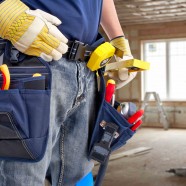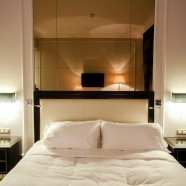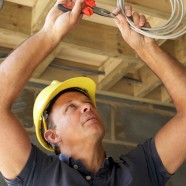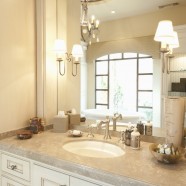5 Tips for Cleaning Up After an Interior Fit-Up
An interior fit-up makes good business sense. Instead of doing every individual job piecemeal, getting it all done in one sweep will keep your business closed for the shortest amount of time and interrupt the fewest number of days for you and your employees. Even business owners facing new construction benefit from this business-building plan. If your fit-up included electrical installation, and most do, you’re probably left with a large mess to deal with before you can reopen your doors. It’s not just a matter of throwing out the trash. This mess needs special attention.
Disposing of the Dust
If you think dust is just an annoying film that coats your store shelves, you’ve never dealt with the aftermath of an electrical installation. This dust will coat every surface, and stays suspended in the air until you get rid of it. Begin by changing the air filters in your HVAC unit. This is the first line of defense against redeposited dust. Check the filter each day and change it again as soon as it’s needed. Walls are just as likely to harbor dust as floors or shelving. Moisten a towel and wrap it around a broom head, and use the broom to wipe dust from wide expanses of walls. Keep the towel just barely moist to avoid damaging any fresh paint that may have been added.
Livening up the Light Fixtures
The light fixtures are sure to be coated in dust and debris, even if they’ve been newly installed. Use a three-step ladder or other safe device to reach the top of each lighting fixture to remove the dirt. Any soil you knock free will fall onto the dirty room interior, so don’t worry about collecting this or using special tools.
Freeing the Floor of Debris
By this time, you’ve got a floor covered in dirt, dust, and broken materials. Work your way in from the outer edges, picking up the heaviest and bulkiest objects first. This is when the most danger lurks; broken glass, bare wires, and bent nails can be hiding among bits of wallboard or insulation. Use heavy work gloves when picking up discarded objects, or push them outside with a broom or shovel. Once the major pieces of garbage have been removed, sweep the floor. Do it once with a commercial push broom to get rid of the most obvious mess, then move on to a smaller broom or soft dry mop to pick up any remaining dust. Mop the floor, paying close attention to the corners, to finish the floor job.
Inspect Furniture and Appliances
Even if you’ve covered the furniture, a fit-up with electrical installation is such a major piece of work that dust and debris are likely to have worked their way into multiple odd places. Vacuum all the couches, side chairs, and desk chairs. Open all desk drawers and filing cabinets to make sure stray nails or debris haven’t fallen inside. Make a thorough search of the interior of any coffee makers, microwave ovens, or other small kitchen appliances you may have. While dust on the floor is annoying, dirt in your coffee maker can be physically dangerous.
Final Inspections
Once the interior of your business is clean, it’s a great idea to walk through and make sure all the electrical renovations work like you’d planned they would. Turn switches on and off, check every wall outlet with a lamp or other small appliance, inspect lighting fixtures or exit lights that may have been installed to make sure they are cleanly finished and work as expected. Turn on any large equipment such as air compressors or freezers to make sure the power is flowing to them and that they work.
Read MoreCreating the Electrical Plan for a Home Renovation
A crucial part of your home renovation plan is to figure out the placement of your residential electrical outlets. The outlets in a room are the most visible sign of electricity in a home, and it’s important that you include them in the right places to make using the room convenient without over-using the system. The right electrical renovation plan can increase your new rooms looks as well as it functionality. Professional electrical remodeling services will know local codes and rules when it comes to numbers and types of outlets used in each room of the house. You can generally add outlets where necessary; it’s simply the matter of using the right type of outlet in most areas. Assess each room in your house that’s undergoing the home renovation before building an electrical plan with your contractor.
The Furniture Layout
Although homeowners like to move their furniture from time to time, most rooms have a signature piece that the room is built around. In the bedroom it’s the bed, of course, but in the living room it may be a sofa, an entertainment center, or a matching set of chairs. Always take this signature piece into account when determining where to place electrical outlets. Do you commonly place lamps around this piece? If so, you’ll need outlets on the wall or in the floor next to the furniture. If you have a large set of shelves to anchor the room, you’ll need to make sure these shelves don’t block any planned outlets or switches. It’s simpler if there’s only one obvious place for a piece of furniture to go, but take into account the most common placement you can find.
Lighting Sources
What are the lighting sources planned for the room? A kitchen will need central lighting over any eating areas available, plus dedicated task lighting over counters, work spaces, and stoves. In a living room, you’ll need outlets for ambient lighting for the room in general, plus reading lamps next to cozy chairs and task lighting for crafts or study areas, if needed. You’ll need wiring for any ceiling light you have planned as well as basic outlets planned for around the room.
Powered Items
Your residential electrical plan depends not just on where the outlets should go in reference to your furniture placement, it also depends on how much power you’re likely to need for each room in the house. Kitchens and laundry rooms need heavy duty outlets for large appliances, plus a number of conveniently placed regular outlets for counter top appliances such as microwave ovens and coffee makers. More power is needed in modern living rooms, which should be a concern for anyone considering a home renovation. Today’s living room is likely to contain a large screen television, a stereo system, a gaming system, and possibly a computer or two. Compared to decades ago when many houses were built, this takes up an enormous amount of power.
Special Events
If you normally decorate in a large way for holidays and special events, extra outlets should be part of your plan, but in number and in placement throughout the house. If you typically have a holiday tree in front of the living room window, install extra outlets on that wall or floor to account for the strings of lights you’ll be adding to the tree. If you have massive parties during football season in one room of the house, make sure extra outlets for plugging in warming trays, slow cookers, and portable fridges are a part of your residential electrical plan. Traditions are important. It’s also important to take these traditions into account when drawing up the electrical plan for your home remodel.
Read More6 Types of Security Lighting for the West Palm Beach Home
A security lighting system in your West Palm Beach home is the smartest inexpensive theft deterrent you can find. Thieves and burglars look for homes they can ransack without being seen, and darkness is one of their biggest tools. If your house is well-lit in a multitude of ways, thieves are more likely to move on to one of your less-prepared neighbors when planning a job. Your home is likely your largest investment; it pays to invest in multiple types of security lighting to keep your family and property safe.
#1: Motion Activated Floodlights
It’s smart to install general purpose floodlights that cover your entire yard, but it makes no sense to have them running all night long. That just wastes power and raises your electrical bill. Have your electrical contractor in West Palm Beach install motion activated lights around your property. When someone moves onto your property a bright light will shine on him, preventing him from sneaking into the house under cover of darkness. The sensitivity on these lights can be adjusted to ignore smaller woodland creatures, only turning on when there’s an actual human threat in the area.
#2: Timed Security Lighting
When you want your property at least slightly lit at all times, but still don’t want outrageous electrical bills, timed lighting is what you need. These lights are dimmer than motion-activated floodlights, but they are on a timer, and can be set for a certain number of hours each night. Set the timer for a few hours after you go to bed, or leave outdoor lights on all night until dawn. Either way, you’ll cut your power usage from simply leaving floodlights on all night light.
#3: Coach Lights
When calling on electrical renovation services, include coach lights on your list of possibilities. These lights illuminate sidewalks and driveways, while adding charm and good looks to your property. You’ll be able to safely walk to your car and around your property without the commercial look of traditional floodlights.
#4: Soffit Lights
If deterring thieves is the main purpose of outdoor security lighting, then lighting up the outside of your West Palm Beach house must be crucial for any security plan. Soffit lights aren’t used very often these days, but they can add an element of brightness and visibility to the front of any house. The soffit is the slight overhang on the front of your house face. Soffit lights hang from this overhang, or are built right into it. They supply lighting that bathes the front of the house where the front porch light might be lacking.
#5: Types of Lights
Traditionally, security lighting was with incandescent bulbs, whether set up high on a pole or set into a fixture next to the front door. Today’s electrical renovation services professionals know that LED lighting is brighter, cooler, safer, and less expensive to use in all types of lighting situations. The lights use a fraction of the power that traditional bulbs use, but they’re many times brighter, giving you a safer property for less money. Your contractor can replace any traditional security lights you have with LED lighting during renovations, and if you’re adding a new lighting system, LED bulbs are the preferred way to go.
#6: Solar Lights
For an additional lighting pop, solar lights are an inexpensive choice for your landscape lighting. They generally don’t give off anywhere near the same amount of light as an LED bulb, though, so they should only been seen as an addition, attractive type of lighting to add to your security package. They’re great for placing beside walkways, giving you more secure footing at night, but they’re not useful for primary lighting in your security plan.
Read MoreIncrease Energy Savings by Adding Passive Designs to Your Home
The best way to save money on energy is to not use it in the first place. Passive home designs take advantage of environments that are naturally thrifty when it comes to using energy, and incorporate them into the home. Areas that naturally use less power are cheaper to run, and usually easier to maintain. Even if you already have a home, it’s possible to retrofit passive design elements into your house in order to realize big energy savings, and a home renovation is the perfect time to consider installing some of these elements into your home design.
Landscaping
In environments such as South Florida where cooling is a much bigger issue than heating, keeping out the warmth is the largest use of power for most home HVAC systems. Houses stay naturally cooler inside if the warmth of the sun doesn’t hit the interior. One of the simplest ways to achieve this is by planting smart landscaping around any exposed windows, especially on the ground floor. Bamboo is notoriously fast-growing, and vines on lattice installations provide attractive coverage throughout the year. Both design ideas can shade out the worst of the hot sun in a small amount of time.
Insulation
Keeping your home insulated isn’t just for northerners who need to keep the heat inside against the winter chill. Florida homes need to keep the cool air inside, leaving as much heat outside as possible. Installing an upgrade on your home’s insulation during a home remodeling can help to keep the right environment inside your home, saving you power and money by lowering the need for air conditioning throughout the day. Look to your attic insulation as well as that in the walls when deciding on where your insulation dollars will do the most good.
Heat Distribution
One of the worst culprits for power usage is in rooms that gather and hold the heat. Having a system to distribute and spread the heat around throughout the house helps to keep energy costs low. After all, one extremely hot room in your house is enough for most air conditioning systems to kick on until that room has cooled. Add a series of ceiling fans through your house during your home remodeling. Your electrical contractor can easily add them to the design plan, and during a renovation is the ideal time to include a major addition such as large ceiling fans.
Solar Panels
There’s a reason they call it the Sunshine State. In Florida, the sun shines down for a portion of almost every single day. Passive solar energy panels are among the most intelligent additions you can add to your home, when looking for passive energy savings. Once they’re installed, you don’t have anything else you have to do in order to realize massive savings on your energy bills. Some users even create so much energy from their solar panels that they are able to sell power back to the energy company. Speak with a licensed electrical contractor to make a plan to install solar power panels on the roof of your home, garage, or other buildings. This one change alone can make enough difference to pay for itself in just a few years, giving you free power for years after that.
Read More5 Wiring Problems You Can Solve During a Home Renovation
Some electrical wiring problems aren’t dangerous, so they’re not worth tearing apart a room just to upgrade your system. They can be annoying, though, and they’re the perfect candidates for extra projects during a home renovation. Whether your electrical wiring is from your grandmother’s time, or it just got installed the last decade, it can be outmoded and ready for replacement if it’s causing problems. Work with your electrical contractor when planning your home rewiring job to include extra wiring problems you may have.
Lights Flickering When It’s Windy Outside
Unlike some of the annoying circumstances you can fix during a home rewiring bout, this one can actually be dangerous and should be taken care of as soon as possible. The spot where the power lines connect with your house is attached to a fixture. When the wind blows the line around and it rubs on the fixture, parts of the line can fray and cause small breaks in service. These small breaks can cause sparking and a fire hazard, especially during rain storms which is typically when high winds occur. Speak with your utility company. They’ll probably replace your fixture for free, although a home renovation is a good time to do this as you can coordinate your décor with the electrical work.
Too Few Outlets
If your family has grown, your need for electrical power has probably grown even quicker. A home renovation is the perfect time to add more electrical wiring for more outlets in each wall. Families have varied needs for extra outlets, such as:
- A home office with extra computers and printers
- Teenager’s rooms with televisions and stereos
- Outdoor kitchens on decks or patios
- Kitchens with lots of new small appliances
If you’re relying on multiple power strips and extension cords for your everyday life, it’s time to get an upgrade. Your electrical contractor can easily include extra outlets in your renovation plan, solving the problem of having to unplug some appliances before plugging in others.
No GFCIs Installed
GFCIs, or Ground Fault Circuit Interrupters, are designed to immediately turn the electricity off if the plugged-in item comes in contact with water or other types of moisture. These safety features are standard in bathrooms and kitchens, but if you’ve got an older home they may be missing from your rooms. It’s a very simple task for your electrician to switch out one type of outlet for another during a home rewiring job, but it’s crucial for your family’s safety, and may even be required for a renovation, depending on your particular city’s building codes.
Plugs Fall Out of Outlets
You plug in a lamp, and an hour later the plug is laying on the floor. No, you don’t have poltergeists; you just have an older electrical system in your house. Outlets should grip the end of the plug when it’s inserted into the holes. When the clip that’s designed to hold the plug wears out, it allows the plug to slip out and fall to the floor. Unfortunately, this situation can cause arcs, sparking, and a fire hazard. Have your contractor change these outlets as soon as possible.
Power Upgrade Needed
If you’re relying on fans to get through a Florida summer, your home probably needs a power upgrade. With the right type of wiring, adding an air conditioner can result in a surprising amount of energy savings in the long run, between the cold showers you avoid and the efficiency of today’s EnergyStar appliances. A home renovation is the perfect time to upgrade your circuit breaker and wiring, as well as installing new major
Read More5 Great Bathroom Lighting Ideas
When it comes to choosing rooms to remodel, bathrooms are always near the top of almost every homeowner’s list. Families grow, styles change, and fixtures seem to look dated quicker than in other parts of the house, so bathroom renovation is a natural choice after just a few years.
After you’ve decided on the bathtub and the color scheme, consider how lighting can become the final touch that brings the room together. Nothing completes a room like the right lighting scheme, and few decorating accents can do so much with such a small amount of effort and money.
Layer the Light
If your bathroom lighting consists of one fixture in the middle of the ceiling, you’re in desperate need of an upgrade. While a single ceiling light might give you enough light to shower by, it doesn’t do anything for the look of the room. Task lighting will give you layers of light while adding warmth to the space. Put in a light above the shower or bath, flank the dressing mirror with side lights, and even add tiny lights along the bottom of the wall to stand in for old-fashioned night lights.
Use Non-Traditional Lighting
A complete bathroom renovation calls for a complete rethinking on your lighting scheme. Why stick with traditional bathroom ceiling lights in your sleek new room? Consider other types of light sources to give your bathroom a unique designer look while lighting up the space. Try bean pot lamps or candlestick lights on a side table, hanging kitchen lights over the vanity, or small electric candles through the room for a soft, romantic glow.
Vanity Lighting
If your bathroom design doesn’t leave much room for dedicated vanity lighting, add light sconces directly onto the surface of the mirror. The mirror behind the lights will double the brightness, giving the room twice as much light in a very small space.
Lighting as Decor
Bathroom lighting doesn’t have to be a simple utility. When you choose the right fixtures, the lighting can become a crucial part of your bathroom design:
- Sleek, modern rooms look great with lots of chrome lamps and fixtures.
- If your design flair leans toward the funky, incorporate strings of rope lighting wound around the curtain rods.
- For a room that is romantic and ruffled, bring in some bedside lamps and candle sconces to continue the theme.
- If this bathroom is mainly for the kids, use lamps in bright primary colors, or check the bedroom department for colorful lamps with their favorite cartoon characters on them.
You may have to change things out as your (or the kids’) interest wanes, but then it will give you a good excuse to give the room a makeover.
Use Multiples
When it comes to bathroom lighting, if one is good, then many are better. Plan a design that includes multiples of all the lights you plan to install. Instead of one central light fixture, install three or five hanging bulbs with decorative shades on different lengths of cord. Group bunches of electric candles on the back of the toilet. Use multiple small bulbs around the vanity mirror instead of one or two smaller ones. More always looks rich and abundant, and it takes your room away from the cookie-cutter design look.
Some lighting changes are a snap to do on your own, but some require a licensed professional electrician to install them safely. When you speak with your electrical contractor and plan your bathroom renovation, let him know about the lighting designs you want to use so he can incorporate them into his renovation schedule.
Read More






Recent Comments